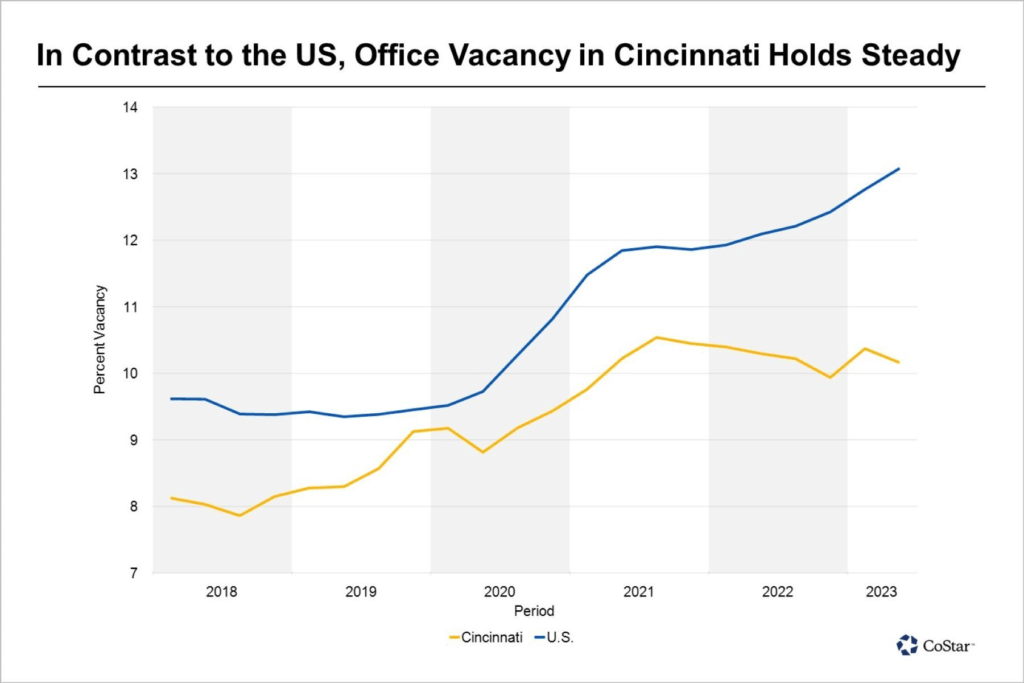Residential Conversions Lead to Healthy Downtown Cincinnati Office Fundamentals
Not long ago, cities across the Midwest were suffering from disinvestment and a dearth of downtown growth. These cities became known as “donut hole” cities due to population centers that moved from the downtown core to outer-ring suburbs. The downtown cores of these cities were somewhat busy during the day, but virtually abandoned after 5pm and on weekends as most office workers drove back to their homes in the suburbs after work.
Now, cities across the Midwest are experiencing a collective renaissance as re-urbanization draws people, business and investments back toward urban centers in search of an authentic live-work-play lifestyle. This trend is accelerating demand for new housing in the downtown cores of these cities, and Cincinnati is no exception.
Cincinnati Rental Housing Demand Soaks Up Obsolete Office Space
In Cincinnati, much of this new residential demand in the downtown core has been met by converting nearly obsolete office space into new residential units. In fact, Cincinnati ranks 7th in the country for office to residential conversions. The result is that large amounts of obsolete office space is being taken off the market in Cincinnati, and this is leading to downtown office fundamentals that are stronger than the national average by at least one important measure: average vacancy rates.
Since 2012, almost 3 million square feet of mostly vacant Class B and C office space have been successfully converted to residential or hotel use, and the vacancy rate for downtown Class A office space has decreased from 25.3% in 2014 to 10% today. Prior to COVID, these conversions also helped increase rents on remaining downtown Class B office space, and they also helped narrow the gap between Class B and Class A office rents.
Office to Residential Conversions Have Helped Stabilize the Cincinnati Office Market
Today, these conversions are helping create a stable vacancy rate in downtown Cincinnati, even while the national average office vacancy rate moves higher. At 10%, office vacancy in Cincinnati is only 70 basis points above the 10-year average. In comparison, the U.S. is 270 basis points above its 10-year average.

Cincinnati’s Most Notable Office to Residential Conversions
Cincinnati’s institutional scale downtown office to residential conversion craze was arguably kicked off by the successful conversion of the 580 Walnut Building into AT 580, a 180-unit Class A apartment building in the heart of downtown. A number of prominent conversions followed, including 294 new Class A apartments created from formerly vacant office space known as City Club, and the conversion of the former Provident Bank headquarters building into 161 new apartment units.
Phase 2 of the City Club project is now underway, and it is the conversion of the nearly 70% vacant but iconic PNC Tower into approximately 262 new apartments units. Other notable conversions now underway include the Textile Building, which is being converted into 282 new apartment units, the conversion of the Mercantile Building into 172 new residential units, and the conversion of 830 Main Street into 60 new residential units, and the conversion of the Terrace Plaza Plaza hotel into 160 new apartment units as well as new retail and commercial space
Downtown Cincinnati Multifamily Rental Demand Remains Strong
Despite these new deliveries, which total almost 2,000 new apartment units, demand for apartments in downtown Cincinnati remains healthy. The amenities provided by Cincinnati’s architecture and history helps contribute to a uniquely authentic urban live-work-play lifestyle downtown, and the new residential units created through office conversions is increasing “feet on the street.” This is leading to brand new amenities for downtown living, which in turn is making the downtown lifestyle ever more attractive. This is part of the reason why Cincinnati leads the nation in rent growth, and it’s why we are fundamentally bullish on Cincinnati multifamily investments.
